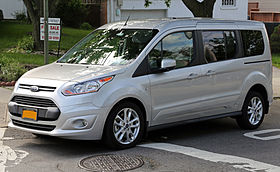Ford Transit Connect
| Ford Transit Connect | |
|---|---|

2014–2015 Transit Connect in Germany
|
|
| Overview | |
| Manufacturer | Ford Europe |
| Also called | Ford Tourneo Connect |
| Production | 2002–present |
| Body and chassis | |
| Class |
Leisure activity vehicle Compact panel van |
| Body style | |
| Layout | Front-engine, front-wheel-drive |
| Chronology | |
| Predecessor |
|
| First generation | |
|---|---|

Post-facelift model
|
|
| Overview | |
| Also called | Ford Tourneo Connect Azure Transit Connect Electric |
| Production | 2002–2013 |
| Assembly |
Kocaeli, Turkey (Ford Otosan) Craiova, Romania (Ford Romania) 2.0L engine: Valencia, Spain (Ford Valencia) |
| Body and chassis | |
| Body style | 3/4-door panel van 5-door LAV |
| Platform | Ford C170 platform |
| Related | Ford Focus |
| Powertrain | |
| Engine | 1.8L Duratorq TDCi Diesel I4 1.8 Endura-D TDDi Diesel I4 2.0L Duratec Gasoline I4 |
| Transmission | 4-speed 4F27E automatic 5-speed manual |
| Dimensions | |
| Wheelbase | SWB: 2,664 mm (104.9 in) LWB: 2,912 mm (114.6 in) |
| Length | 2004–06 SWB: 4,278 mm (168.4 in) LWB: 4,555 mm (179.3 in) 2007–09 SWB: 4,308 mm (169.6 in) 2010– LWB: 4,590 mm (180.7 in) 2010– SWB: 4,275 mm (168.3 in) |
| Width | 1,795 mm (70.7 in) |
| Height | Pre–2009 SWB: 1,814 mm (71.4 in) LWB: 1,981 mm (78.0 in) 2010– LWB: 2,014 mm (79.3 in) 2010– SWB: 1,815 mm (71.5 in) |
| Curb weight | XL with 2.0L: 3,373 lb (1,530 kg) XLT Wagon with 2.0L: 3,503 lb (1,589 kg) XLT Wagon (Premium) with 2.0L: 3,524 lb (1,598 kg) |
| Second generation | |
|---|---|
 |
|
| Overview | |
| Production | 2012–present |
| Model years | 2013–present (Europe and Turkey) 2014–present (North America) |
| Assembly | Almussafes, Valencia, Spain (Valencia Body & Assembly) |
| Designer | Paul Wraith |
| Powertrain | |
| Engine | 1.0 L EcoBoost I3
|
| Transmission | 6-speed PowerShift semi-automatic (twin-clutch) 6-speed manual B6 5-speed manual iB5 |
| Dimensions | |
| Wheelbase |
|
| Length |
|
| Width | 72.2 in (1,830 mm) |
| Height |
|
| Curb weight |
|
The Ford Transit Connect is a compact panel van developed by Ford Europe and derived from the Ford Focus. The first generation was designed by Peter Horbury and introduced in 2002 to replace the older Ford Escort and Fiesta-based Courier van ranges, which had ceased production in the same year. It has been imported to the North American market since the 2010 model year. In North America, the Transit Connect does not have a direct predecessor; the closest vehicle to its size was the standard-length Ford Aerostar cargo van, which ceased production in 1997.
The Ford Tourneo Connect, a leisure activity vehicle, is a Transit Connect with side windows and rear seats. All Transit Connects bound for the United States are imported in this configuration to avoid the 25% "chicken tax" on imported light trucks. In 2013, US Customs told Ford that they must stop this practice of importing vans disguised as passenger cars.
The Transit Connect was introduced in Europe in October 2002 as the replacement for sedan delivery vans based on the Escort and the Fiesta. Production of the Escort in Europe ceased in 2000 (although the vans carried on for another two years), whilst the Fiesta Courier was also planned to be discontinued when the fifth generation Fiesta entered production in 2002. Ford elected not to develop a direct sedan delivery version of the Focus, instead pursuing a purpose built design.
Sharing few components with the much larger Transit, the Transit Connect was based on the front-wheel drive C170 platform shared with the international Ford Focus, then common with the first generation North American Ford Focus. Rather than adapting an existing bodystyle into a van, the Transit Connect was designed with sliding side doors.
...
Wikipedia
